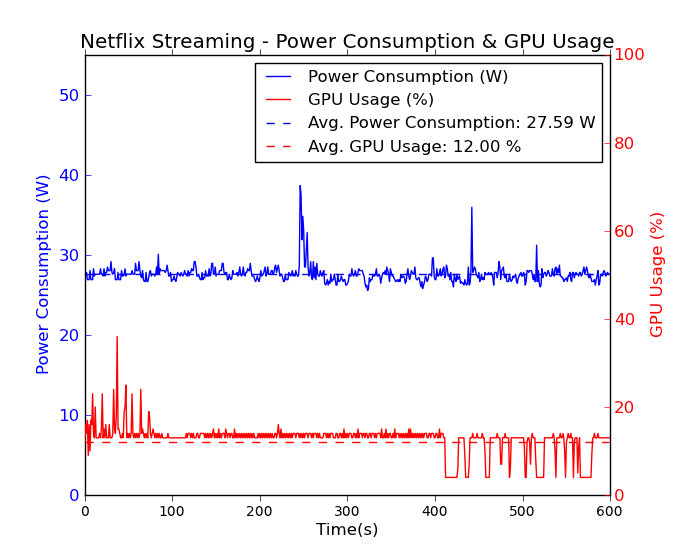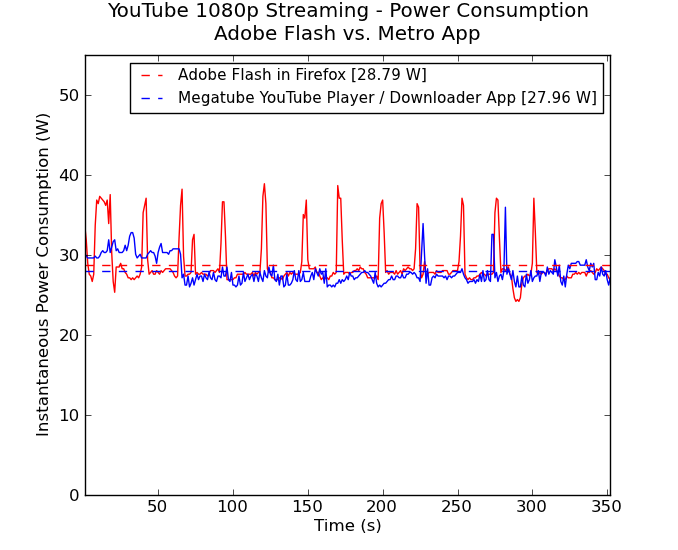Intel's Haswell - An HTPC Perspective: Media Playback, 4K and QuickSync Evaluated
by Ganesh T S on June 2, 2013 8:15 PM ESTNetwork Streaming Performance - Netflix and YouTube
The move from Windows 7 to Windows 8 as our platform of choice for HTPCs has made Silverlight unnecessary. The Netflix app on Windows 8 supports high definition streams (up to a bit rate of 3.85 Mbps for all ISPs, more if the ISP is Super HD enabled) as well as 5.1-channel Dolby Digital Plus audio on selected titles.
It is not immediately evident whether GPU acceleration is available or not from the OSD messages. However, GPU-Z reported an average GPU utilization of 12% throughout the time that the Netflix app was playing back video. The average power consumption is around 28 W.

Unlike Silverlight, Adobe Flash continues to maintain some relevance right now. YouTube continues to use Adobe Flash to serve FLV (at SD resolutions) and MP4 (at both SD and HD resolutions) streams. YouTube's debug OSD indicates whether hardware acceleration is being used or not.
Windows 8 has plenty of YouTube apps. We chose the Megatube YouTube Player / Downloader which allows for stream selection. For our power measurement experiments, we chose the 1080p MP4 stream.
However, we can't be sure whether hardware acceleration is being used with the app, as there is no debug OSD. However, a look at the power consumption numbers reveal that both approaches consume less than 30 W on an average. The difference in the caching of the stream is also visible in this graph, with the Flash approach preferring to download data in bursts while the app prefers to download the whole stream as quickly as possible. Streaming was done over Wi-Fi.

Comparing these numbers with what was obtained using the i3-3225 in a passive build shows that the Haswell build manages to be more efficient even when active cooling (with one big Antec Skeleton chassis fan and a CPU fan) is employed.
On the image quality front, Haswell doesn't seem to change anything here vs. Ivy Bridge. Performance was acceptable before, and it continues to be so here. The big difference is really the additional power savings.













95 Comments
View All Comments
Surlias - Friday, December 6, 2013 - link
Hey, I just bought my first 120 Hz capable HDTV, and I'm wondering how to configure it for both gaming and proper 24p media playback. Can I set the a custom resolution of 1920x1080 @ 120 Hz (GTX 770) just like you can with a 120 Hz monitor, and then leave it at that setting all the time? Then games would be able to do VSync up to 120 fps, and media would be able to lock in at 24p because it's an even divisor of 120. Or is this not possible on a TV due to HDMI limitations? If this is the case, then will it be necessary to manually switch back and forth between 60Hz and a 24 Hz custom resolution depending on the usage situation (since 24 Hz would be awful for gaming)? I've always found this particular subject confusing and I'm hoping someone can help me understand how this works. FYI, I mostly use XBMC for media playback, which has an option to "sync to display refresh rate", which I assume would be essential for enabling 24p playback.redmist77 - Tuesday, April 8, 2014 - link
I'm amazed at how well Haswell locks the video and audio sync. I can output 23.976Hz video to my plasma TV and all of the AV sync graphs in MediaPortal or MPC-HC are *dead* flat and there's never a stutter. 24Hz, 50Hz and 59.94Hz are all perfect too. That's possibly the holy grail of a HTPC. I haven't found any other bugs (DXVA2 etc.) either so it's looking good. DTS-HD, Dolby True HD bit streaming also works perfectly. 0-255 RGB HDMI output requires a registry fix but that's no big deal (default is 16-235)The next great challenge is a gaming HTPC that uses Intel 4600 for video and a giant PCI-E card when launching a game ;) I've sort of got it working using DisplaySwitch.exe and two HDMI inputs on my AV receiver but it's not quite seamless.
khmara - Friday, May 30, 2014 - link
The flickering that is seen during the test with the Haswell in 4k on the Seiki 4k TV was due to Intel graphics settings having the refresh rate default at 29. If you manually change it to 30 the flickering is eliminated.Tassadar - Thursday, June 12, 2014 - link
Hi all,I have a HTPC with an intel haswell and I can't get 23,97 fps, I have 24 even if i set 23 in intel panel properties.
I have run CustomModeApp.exe but I only can enter entire numbers (no decimals) in the frequency. I also have try 23 but doesn't allow me to accept.
Any help?
Thanks
Gadgety - Monday, August 18, 2014 - link
"... but the HDMI link never got locked (the display would keep flickering on and off). The frequency of locking was inversely proportional to the HDMI cable length... We will update this section as and when we reach closure on the issue with ASRock / Intel."This was in June 2013. Still no closure after 13 months?